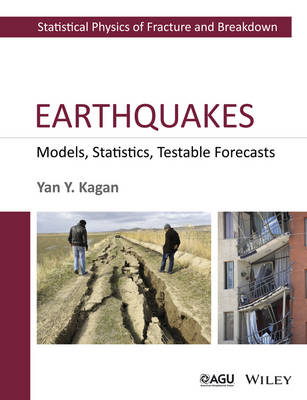
Earthquakes
American Geophysical Union (Verlag)
978-1-118-63792-0 (ISBN)
- Titel z.Zt. nicht lieferbar
- Versandkostenfrei
- Auch auf Rechnung
- Artikel merken
Yan Kagan grew up and was educated in Moscow, Russia. In 1974 he came to UCLA, and working with Leon Knopoff, David Jackson, Peter Bird, and Frederick Schoenberg applied his mathematical/statistical model to seismicity analysis. Since 1999 these results have been used to produce daily earthquake forecasts for several seismically active regions and currently for the whole Earth. The performance and predictive skill of these forecasts is now being tested by several research groups.
Preface xiii
Acknowledgments xvii
List of Abbreviations xix
List of Mathematical Symbols xxi
PART I MODELS 1
1 Motivation: Earthquake science challenges 3
2 Seismological background 6
2.1 Earthquakes 6
2.2 Earthquake catalogs 8
2.3 Description of modern earthquake catalogs 11
2.4 Earthquake temporal occurrence: quasi-periodic, Poisson, or clustered? 14
2.5 Earthquake faults: one fault, several faults, or an infinite number of faults? 16
2.6 Statistical and physical models of seismicity 18
2.7 Laboratory and theoretical studies of fracture 19
3 Stochastic processes and earthquake occurrence models 21
3.1 Earthquake clustering and branching processes 21
3.2 Several problems and challenges 24
3.3 Critical continuum-state branching model of earthquake rupture 26
PART II STATISTICS 31
4 Statistical distributions of earthquake numbers: Consequence of branching process 33
4.1 Theoretical considerations 34
4.2 Observed earthquake numbers distribution 43
5 Earthquake size distribution 54
5.1 Magnitude versus seismic moment 54
5.2 Seismic moment distribution 56
5.3 Is 𝛽 ≡ 1¨M2? 60
5.4 Seismic moment sum distribution 80
5.5 Length of aftershock zone (earthquake spatial scaling) 86
5.6 Maximum or corner magnitude: 2004 Sumatra and 2011 Tohoku mega-earthquakes 90
6 Temporal earthquake distribution 96
6.1 Omori’s law 96
6.2 Seismic moment release in earthquakes and aftershocks 97
6.3 Random shear stress and Omori’s law 107
6.4 Aftershock temporal distribution, theoretical analysis 110
6.5 Temporal distribution of aftershocks: Observations 116
6.6 Example: The New Madrid earthquake sequence of 1811–12 121
6.7 Conclusion 123
7 Earthquake location distribution 125
7.1 Multipoint spatial statistical moments 125
7.2 Sources of error and bias in estimating the correlation dimension 127
7.3 Correlation dimension for earthquake catalogs 141
7.4 Conclusion 145
8 Focal mechanism orientation and source complexity 146
8.1 Random stress tensor and seismic moment tensor 147
8.2 Geometric complexity of earthquake focal zone and fault systems 150
8.3 Rotation of double-couple (DC) earthquake moment tensor and quaternions 154
8.4 Focal mechanism symmetry 159
8.5 Earthquake focal mechanism and crystallographic texture statistics 163
8.6 Rotation angle distributions 167
8.7 Focal mechanisms statistics 170
8.8 Models for complex earthquake sources 177
PART III TESTABLE FORECASTS 183
9 Global earthquake patterns 185
9.1 Earthquake time-space patterns 185
9.2 Defining global tectonic zones 187
9.3 Corner magnitudes in the tectonic zones 188
9.4 Critical branching model (CBM) of earthquake occurrence 190
9.5 Likelihood analysis of catalogs 197
9.6 Results of the catalogs’ statistical analysis 204
10 Long- and short-term earthquake forecasting 206
10.1 Phenomenological branching models and earthquake occurrence estimation 206
10.2 Long-term rate density estimates 207
10.3 Short-term forecasts 215
10.4 Example: earthquake forecasts during the Tohoku sequence 218
10.5 Forecast results and their discussion 224
10.6 Earthquake fault propagation modeling and earthquake rate estimation 226
11 Testing long-term earthquake forecasts: Likelihood methods and error diagrams 229
11.1 Preamble 229
11.2 Log-likelihood and information score 230
11.3 Error diagram (ED) 235
11.4 Tests and optimization for global high-resolution forecasts 247
11.5 Summary of testing results 250
12 Future prospects and problems 253
12.1 Community efforts for statistical seismicity analysis and earthquake forecast testing 253
12.2 Results and challenges 254
12.3 Future developments 256
References 260
Index 281
| Reihe/Serie | Wiley Works |
|---|---|
| Sprache | englisch |
| Maße | 196 x 254 mm |
| Gewicht | 862 g |
| Themenwelt | Mathematik / Informatik ► Mathematik |
| Naturwissenschaften ► Geowissenschaften ► Geologie | |
| Technik ► Maschinenbau | |
| ISBN-10 | 1-118-63792-5 / 1118637925 |
| ISBN-13 | 978-1-118-63792-0 / 9781118637920 |
| Zustand | Neuware |
| Haben Sie eine Frage zum Produkt? |
aus dem Bereich


